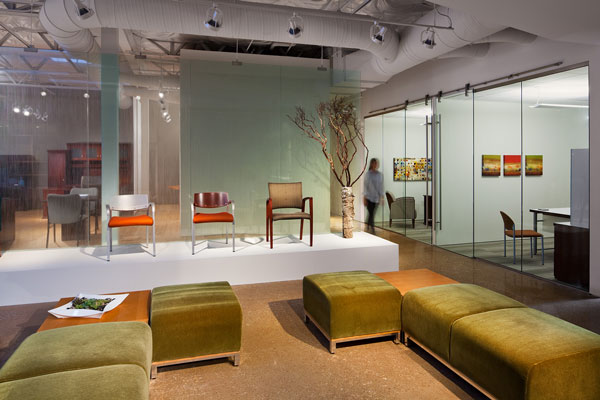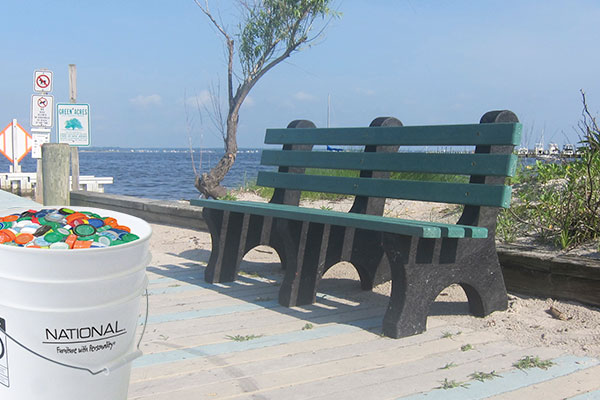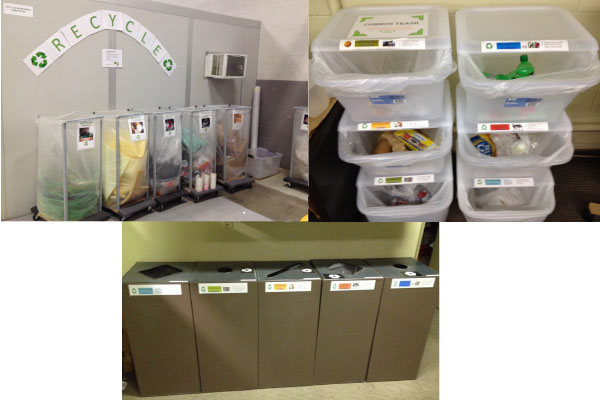Office Furnishings Manufacturer Strives for Zero-waste-to-landfill
By Kate Bachman | May 1, 2014
Category:
National Office Furniture is a prolific producer of high-quality office furniture, but a minimalist producer of industrial waste. The manufacturer strives for zero-waste-to-landfill.
Since its founding in 1980, the furniture builder, a unit of Kimball® International, Inc., a Jasper, Indiana manufacturer of furnishings with annual sales exceeding $1 billion, has worked to build a reputation for stylish furniture, while building on its commitment to environmental responsibility. National Office Furniture has historically concentrated on pollution prevention and waste reduction projects, not only in its plants but also in its communities.
Since 2002, the company has reduced waste being sent to a landfill by 44 percent in absolute tons, and by 55 percent based on normalized pounds per unit produced. Today, virtually 95 percent of total solid waste generated at National is either reused or recycled (see Figure 1).
That National Office Furniture can send most of its recyclables to its parent company’s corporate-wide recycling center certainly helps, said environmental compliance and sustainability manager Rhonda Scherer. The center, which recycles 65 different material types, is the embodiment of the company’s commitment to keep material waste out of the landfills, she said.

Materials diverted from landfills annually include 88 tons of paper, 2,804 tons of cardboard, and 1,234 tons of steel.
In addition, in keeping with the company’s reuse philosophy, many materials are repurposed. Much of the furniture maker’s scrap fabric from its upholstery plant is sent to an upcycler that makes it into vehicle padding. Scrap leather is made into other items such as purses, Scherer relayed.

Figure 1: As part of National Office Furniture’s 2013 Earth Day campaign, it devised a program and goal to recycle enough plastic bottle caps and container lids to make into a park bench and find it a worthy home. That home turned out to be the Bayside Children’s Park in Seaside Park, N.J., an area heavily impacted by Hurricane Sandy. National employees collected more than 400 pounds of plastics lids and caps to be recycled into a weather-resistant park bench, part of the community’s “restore the shore” campaign.
Wood waste is either given to farmers for animal bedding or used at one of the company’s sites as a fuel substitute for coal.
“Our management made a commitment that after the year 2012, we would significantly reduce our use of coal to help us reduce our GHG emissions,” she said.
How Achieved
The 95 percent landfill diversion was achieved by efforts both internal and external:
- Increased employee awareness and engagement
- Audited dumpster dives
- Eliminated common waste containers; replaced with labeled recycling containers
- Implemented return-to-vendor programs to facilitate reuse
- Refused extra packaging from vendors
- Reduced waste upstream within internal processes
Scherer said that the biggest reason for the program’s success is that the employees own the program. “Our recycling program is actually owned by our employees through their involvement (see Figure 2). They drive a lot of the recycling. They’ll say, ‘I can recycle this if you can get me a container for it,’ or they’ll bring a piece of material that we currently don’t recycle and ask, ‘Can we recycle this?’”
“They bring those ideas to us because they see that product every day,” she added.

Figure 2: Locating recycle bins in mailrooms, break rooms, office areas, and on the production floor keeps them in front of employees and makes it easier to comply. Stackable recycle bins work great for limited floor space. Rolling carts on the production floor provide mobility to accommodate process changes and are ergonomically friendly.
Scherer said that when the company implemented ISO 14001, it educated employees about reducing greenhouse gases and landfill waste, which helped change the company culture. So, too, did making it easy for them to recycle by placing recycling bins in strategic places.
“We all look for ways that we can improve the environment. It’s something that’s a given now. It changed the culture. As a result, we’ve seen a huge reduction in all of our environmental metrics.”
Rather than just celebrating Earth Day on Apr. 22, the company celebrates Earth month throughout April with activities, posters, and employee contests.
Vendor Responsibility
The manufacturer also partners with its suppliers to reduce excess packaging where applicable.
“Employees often bring situations to our attention. For example, components were being shipped in plastic bags with cardboard between them in a large cardboard box. The employee approached me and said, ‘Look, Rhonda, we are unbagging these interior parts, but they aren’t really needed to protect the product.’ We removed the plastic bags. It was a timesaver.”
Scherer said the change went over well with the vendor as well. “In some cases where we found we could reduce the packaging, it was not only more efficient for us within production, it actually made it easier for the vendor, too.”
The furniture maker implemented a take-back program also, partnering with a furniture and fixtures repurposing organization called ANEW. ANEW’s slogan is “Transforming corporate surplus into community service™.”
“Let’s say you bought a chair, and that chair has reached the end of its lifespan. Our customers can work with ANEW, which will either donate the product or disassemble and then recycle or refurbish it. That keeps it out of the landfill,” Scherer said.
Once progress was made on recycling and upcycling programs, the company looked to reduce waste generation. The company uses “right-sized” product packaging in two facilities, which creates custom-sized boxes to fit each product on demand. “In the past, we needed different standard-sized boxes to ship our product in. The custom packaging system reduces the amount of cardboard that we generate—and the cushioning foam that goes into it,” Scherer said.
Sustainability isn’t just a buzz word, the company’s website states. “We start with the end in mind: a better tomorrow; and then we wrap our goals and the path to achieve these goals with social, environmental and fiscal stewardship.”
National Office Furniture, 1205 Kimball Blvd., Jasper, IN 47549, 812-634-3520, www.nationalofficefurniture.com
Editor Kate Bachman can be reached at kateb@sustainablemfr.com.
______________________________________________________________________
Editor’s Note: National Office Furniture Environmental Compliance and Sustainability Manager Rhonda Scherer will explain how the $1 billion sales manufacturer reuses or recycles 95 percent of its solid waste in her presentation at our Sustainable Manufacturer and Water 2.0 Conference & Exhibits May 20-22 in Naperville (Chicago) Ill. Don’t miss it! https://www.fmanet.org/events/conference.
__________________________________________________________________

Side by side, we move metal fabrication forward.
FMA unites thousands of metal fabrication and manufacturing professionals around a common purpose: to shape the future of our industry, and in turn shape the world.
Learn More About FMA


